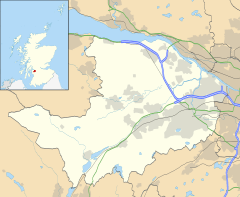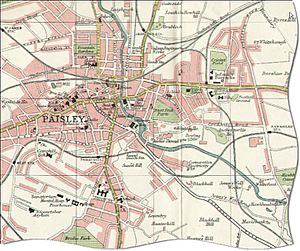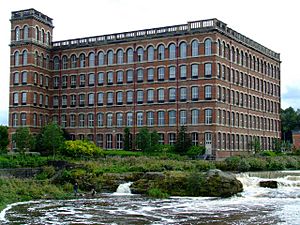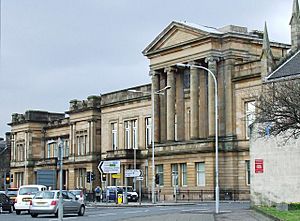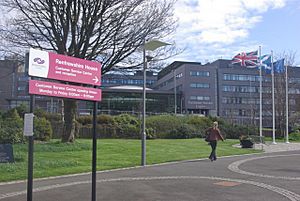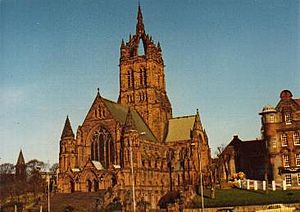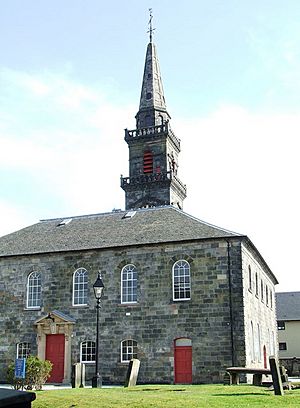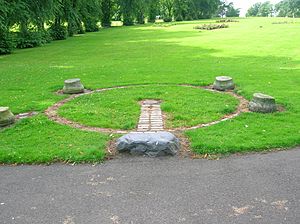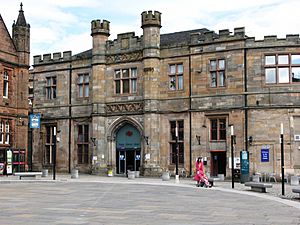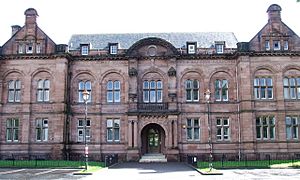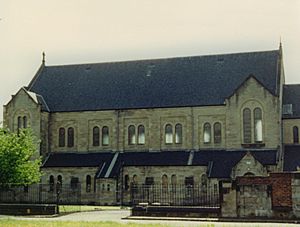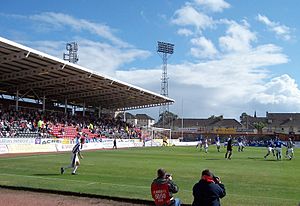Paisley, Renfrewshire facts for kids
Quick facts for kids Paisley
|
|
|---|---|
| Town and administrative centre | |
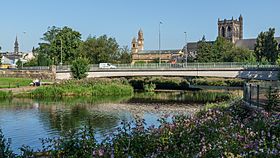 Paisley town centre with White Cart Water. Taken from Seedhill. |
|
| Population | 79,369 (2022) |
| OS grid reference | NS485635 |
| • Edinburgh | 49 mi (79 km) E |
| Council area | |
| Lieutenancy area | |
| Country | Scotland |
| Sovereign state | United Kingdom |
| Post town | PAISLEY |
| Postcode district | PA1 – PA3 |
| Dialling code | 0141 & 01505 |
| Police | Strathclyde |
| Fire | Strathclyde |
| Ambulance | Scottish |
| EU Parliament | Scotland |
| UK Parliament |
|
| Scottish Parliament |
|
Paisley is a large town in the west of Scotland. It's located near the Gleniffer Braes and borders the city of Glasgow to the east. The town sits along the White Cart Water, which is a river that flows into the River Clyde.
Paisley is the main town for the Renfrewshire area. It's often called "Scotland's largest town" and is the fifth biggest place in the country. Even though it's large, it doesn't have "city status."
The town became important in the 1100s when Paisley Abbey was built. This abbey was a major religious center. Paisley grew a lot during the Industrial Revolution because it was next to the White Cart Water. This river helped with trade and access to resources. Many factories and mills were built, and more people moved to the town. Paisley was also known for its involvement in the Radical War of 1820, where striking weavers protested for change.
By the late 1800s, Paisley was famous worldwide for its weaving industry. This is where the famous Paisley shawl and Paisley pattern got their name! However, in the 1900s, the factories started to close. By 1993, all the mills were gone. Today, Paisley is a center for local government and services. Many people who live here travel to work in the wider Greater Glasgow area.
Contents
- Paisley's Past: A Look at History
- How Paisley is Governed
- Public Services in Paisley
- Paisley's Geography and Weather
- Paisley's Economy and Jobs
- Famous Places and Buildings in Paisley
- Getting Around Paisley: Transport
- Learning in Paisley: Education
- Religion in Paisley
- Paisley in the Media
- Sports in Paisley
- Famous People from Paisley
- International Connections
- See also
Paisley's Past: A Look at History
The name Paisley has changed over time, like Paislay and Passelet. No one is completely sure where the name came from. Some think it means "pasture" or "major church" in an old language. Others believe it comes from an Old English name, "Pæssa," meaning "Pæssa's wood" or "clearing." The Gaelic spelling is Pàislig.
Paisley started as a religious settlement. It's believed that an Irish monk named Saint Mirin built a chapel here around the 500s or 600s. Later, in 1163, a priory (a type of monastery) was built. This priory became Paisley Abbey in 1245. The Abbey was very important to the Bruce and Stewart royal families. It's even thought that William Wallace, a Scottish hero, was educated here. King Robert III was buried in the Abbey. You can still see the tomb of Princess Marjorie Bruce, who was an ancestor of the Stewart kings.
In 1488, Paisley became a "Burgh of Barony," which meant it had special trading rights. This helped the town grow. The first school was set up by the town council in 1577.
In 1697, Paisley was the site of the last mass execution for witchcraft in Western Europe. Seven people were found guilty and five were executed. A horseshoe was placed on their burial site to keep evil away. A bronze horseshoe is still there today, reminding people of this sad event. It says: "Pain Inflicted, Suffering Endured, Injustice Done."
How the Industrial Revolution Changed Paisley
The Industrial Revolution, driven by the textile industry, transformed Paisley from a small market town into a major industrial hub in the late 1700s. Many factory owners from England came here. People from other parts of Scotland moved to Paisley because the mills offered jobs, even for women and children.
At first, Paisley was known for silk. But in 1790, silk went out of style. The mills then started making shawls that looked like expensive Kashmir (cashmere) shawls. These became known as "Paisley" shawls. Under the leadership of Thomas Coats, Paisley became the world's center for making thread.
However, the skilled weavers of Paisley also became involved in protests. This led to the "Radical War" of 1820, which didn't succeed. Too many shawls were being made, and the market for them collapsed. This, along with other problems in the textile industry, meant that weaving became less important.
By the mid-1800s, weaving was still the town's main industry. The most famous product was the Paisley shawl, with its unique teardrop pattern. This pattern became very popular after young Queen Victoria wore it. Even though the design came from Kashmir and was made elsewhere, it became known as the Paisley Pattern worldwide. The shawls went out of fashion in the 1870s, but the Paisley pattern is still a symbol of the town. The Paisley Museum has a large collection of these original shawls.
Politics and Helping Others in Paisley
Paisley became known as a town where people were well-read and often had strong opinions. Between 1816 and 1820, it was a key location for the Radical War. There were large protests, cavalry charges down the main street, and even riots. Some people even thought about trying to overthrow the government! The weavers of Paisley were very active in these events. The Prime Minister at the time, Benjamin Disraeli, even said, "Keep your eye on Paisley."
Paisley's annual Sma' Shot Day celebrations happen on the first Saturday of July. They started in 1856 to remember a disagreement between weavers and their bosses. The dispute was about payment for "sma' shot," a small cotton thread that was hidden but essential for holding clothes together.
A military base, Paisley Barracks, was built in the town in 1822.
The economic crisis of 1841-1843 hit Paisley very hard. Most of the mills closed, and many owners went bankrupt. A quarter of the town's population needed help. The Prime Minister, Sir Robert Peel, stepped in. He got more money for relief and sent someone to Paisley to make sure it was given out properly. He even convinced Queen Victoria to wear Paisley products to help boost sales.
During the American Civil War (1861-1865), cotton supplies to Paisley's mills were cut off. By 1862, there were huge shortages and many mills shut down. There were no other jobs for the workers, and local authorities didn't want to provide help. People tried to help voluntarily, but it wasn't enough. The unemployed workers blamed officials in London for their problems, not the United States.
The Famous Paisley Snail Case
Paisley was also the setting for a very important legal case. In 1928, a woman in a Paisley cafe claimed she found a dead snail in her bottle of ginger beer and became ill. She sued the company that made the drink for being careless. Back then, a company was only responsible if there was a direct contract with the person who was harmed.
However, after the case, known as Donoghue v Stevenson, went through the courts, a new rule was set. It said that manufacturers (and other people) have a duty to avoid causing harm to others through carelessness, even if there's no contract. This case was a big step for modern law about negligence and is often called the "Paisley snail" case.
Paisley in the Second World War
Because Paisley had many factories, it was a target for German bombers during World War II. While it wasn't bombed as much as nearby Glasgow, air raids still happened. On May 6, 1941, a bomb killed 92 people. This was the worst disaster in Paisley's history.
The Gleniffer Braes, just outside Paisley, had "decoy ponds." These were fake airfields used by the RAF to confuse German spies.
How Paisley is Governed
Paisley is the main administrative center for the Renfrewshire Council. It's also part of the historic area of the same name. For local representation, the town is divided into Community Councils.
In the Scottish Parliament, Paisley is represented by George Adam MSP. For the UK Parliament, the town is split between two areas: Paisley and Renfrewshire North (represented by Alison Taylor MP) and Paisley and Renfrewshire South (represented by Johanna Baxter MP).
Public Services in Paisley
Paisley has its own police service, which is part of the Renfrewshire and Inverclyde Division. The town is divided into five community policing areas. For legal matters, the area is part of North Strathclyde.
NHS Greater Glasgow and Clyde provides healthcare in Paisley. The main hospital with emergency services is the Royal Alexandra Hospital. The Strathclyde Fire and Rescue service covers Paisley, with a fire station on Canal Street.
Scottish Water provides water and sewerage services in Paisley. Renfrewshire Council collects the charges for these services along with council tax. The council is also in charge of waste management. Scottish Power is the company that supplies electricity to homes and businesses.
Paisley's Geography and Weather
Paisley's Landscape
Paisley is mostly built on low ground, about 12 meters (40 feet) above sea level. The White Cart Water river flows right through the town center. There are also some hills that the town has grown to include. Historically, Paisley started around Oakshaw, a hill north of the main High Street. Oakshaw is now a protected area, and you can find many important buildings there, like the High Kirk and the Coats Observatory.
Paisley grew a lot, especially during the Victorian and Edwardian times, creating many new neighborhoods. Castlehead is a leafy area with many Victorian houses where rich factory owners lived. Thornly Park is another protected area to the south, with different styles of houses, from old-fashioned to Art Deco. Many of these houses were designed by W. D. McLennan, who was a friend of the famous architect Charles Rennie MacIntosh.
After World War II, Paisley expanded into the countryside, and new housing areas were built. These include parts of Glenburn, Foxbar, Ferguslie Park, Gallowhill, and Hunterhill. Local parks like Fountain Gardens and Barshaw Park offer green spaces.
On the edges of town are places like Ralston. This was once outside Paisley but is now considered a suburb.
Paisley's Climate
| Climate data for Paisley, elevation: 16 m or 52 ft, 1981–2010 normals, extremes 1959–present | |||||||||||||
|---|---|---|---|---|---|---|---|---|---|---|---|---|---|
| Month | Jan | Feb | Mar | Apr | May | Jun | Jul | Aug | Sep | Oct | Nov | Dec | Year |
| Record high °C (°F) | 13.5 (56.3) |
14.4 (57.9) |
17.2 (63.0) |
24.4 (75.9) |
26.5 (79.7) |
29.6 (85.3) |
30.0 (86.0) |
31.0 (87.8) |
26.7 (80.1) |
22.8 (73.0) |
17.7 (63.9) |
14.1 (57.4) |
31.0 (87.8) |
| Mean daily maximum °C (°F) | 6.9 (44.4) |
7.4 (45.3) |
9.6 (49.3) |
12.6 (54.7) |
15.9 (60.6) |
18.1 (64.6) |
19.7 (67.5) |
19.2 (66.6) |
16.4 (61.5) |
12.7 (54.9) |
9.4 (48.9) |
6.9 (44.4) |
12.9 (55.2) |
| Daily mean °C (°F) | 4.4 (39.9) |
4.6 (40.3) |
6.3 (43.3) |
8.7 (47.7) |
11.6 (52.9) |
14.1 (57.4) |
15.9 (60.6) |
15.5 (59.9) |
13.1 (55.6) |
9.7 (49.5) |
6.7 (44.1) |
4.3 (39.7) |
9.6 (49.3) |
| Mean daily minimum °C (°F) | 1.8 (35.2) |
1.8 (35.2) |
3.0 (37.4) |
4.8 (40.6) |
7.3 (45.1) |
10.1 (50.2) |
12.0 (53.6) |
11.7 (53.1) |
9.7 (49.5) |
6.7 (44.1) |
4.0 (39.2) |
1.7 (35.1) |
6.2 (43.2) |
| Record low °C (°F) | −14.8 (5.4) |
−7.5 (18.5) |
−8.3 (17.1) |
−4.4 (24.1) |
−1.1 (30.0) |
1.5 (34.7) |
3.9 (39.0) |
2.2 (36.0) |
−0.2 (31.6) |
−3.5 (25.7) |
−6.8 (19.8) |
−14.5 (5.9) |
−14.8 (5.4) |
| Average rainfall mm (inches) | 148.2 (5.83) |
104.6 (4.12) |
112.3 (4.42) |
63.6 (2.50) |
67.5 (2.66) |
66.4 (2.61) |
73.0 (2.87) |
92.5 (3.64) |
112.5 (4.43) |
143.1 (5.63) |
126.4 (4.98) |
135.2 (5.32) |
1,245.3 (49.01) |
| Average rainy days (≥ 1.0 mm) | 17.3 | 13.2 | 14.9 | 11.6 | 11.9 | 11.1 | 12.0 | 12.8 | 13.8 | 16.8 | 16.0 | 15.5 | 167.0 |
| Mean monthly sunshine hours | 37.6 | 66.9 | 98.6 | 134.5 | 180.1 | 158.9 | 154.3 | 146.8 | 114.9 | 85.2 | 54.0 | 33.1 | 1,265 |
| Source 1: Met Office | |||||||||||||
| Source 2: KNMI/Royal Dutch Meteorological Institute | |||||||||||||
Paisley's Economy and Jobs
Paisley is home to many important organizations. These include the main offices of Renfrewshire Council, the largest campus of the University of the West of Scotland, and the Royal Alexandra Hospital.
Glasgow Airport, located on the northern edge of Paisley, is a big employer and a key part of the area's transport system. The airline Loganair also has its main office there.
Scotch whisky blenders and bottlers Chivas Brothers (part of Pernod Ricard) are also based in the town.
The area where the old Rootes/Chrysler/Talbot car factory used to be is now the Phoenix Retail Park. Many businesses have invested here, creating shops, car showrooms, restaurants, a cinema, a hotel, and a business center.
Famous Places and Buildings in Paisley
Important Civic Buildings
As the administrative center of Renfrewshire, Paisley has many important public buildings. Paisley Town Hall, next to the Abbey, was paid for by George Aitken Clark, whose family owned the Anchor Mills. Sir Peter Coats, another mill owner, paid for the Paisley Museum and Central Library (built in 1871). The Clark and Coats families were very powerful in Paisley's industry.
The old County Buildings, Police Station, and Jail were torn down in 1821. A newer building, finished in 1890, now houses Paisley Sheriff Court.
Renfrewshire House is the modern headquarters for Renfrewshire Council. It was designed to be a central hub for the town's government. It's considered one of Scotland's important post-war buildings.
Another interesting civic building is the Russell Institute, an art deco building from 1926.
Places of Worship
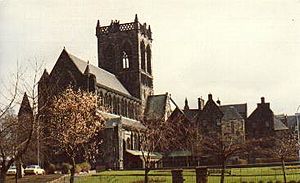
One of Paisley's most striking buildings is its medieval Abbey in the town center, built in the 1100s. The oldest parts show a Romanesque style. The choir (the east end) and tower were rebuilt in the late 1800s and early 1900s in a Gothic Revival style. The roof in the main part of the church was restored in 1981.
The former Thomas Coats Memorial Baptist Church, named after the industrialist Thomas Coats, is a beautiful example of Gothic Revival architecture. Its tall spire, over 60 meters (197 feet) high, stands out in the town's skyline. Opened in 1894, it was once the largest Baptist church in Europe. It's made of red sandstone and has detailed wood carvings, mosaic floors, and marble inside. It also has a huge organ with 3040 pipes!
St Mirin's Cathedral on Incle Street is the main Catholic church in Paisley. It was finished in 1931, replacing an older church from 1808. The original St Mirin's was the first Catholic church built in Scotland since the Reformation. When the Diocese of Paisley was created in 1947, the church became a cathedral.
St Matthew's Church (Church of the Nazarene) is an Art Nouveau style building. It was designed by local architect William Daniel McLennan and built between 1905 and 1907.
Other Interesting Landmarks
Blackhall Manor, built around 1160, is the oldest building in Paisley. It was given to the town in 1940 but was almost torn down in 1978. It was bought privately in 1982 and fully restored as a home.
Because of its history in textiles, Paisley has many examples of Victorian factory buildings. The most famous is the Anchor Mills, built in 1886. This building was turned into apartments in 2005. You can learn more about Paisley's weaving history at the Sma' Shot cottages on Shuttle Street, a small museum showing how weaving was done at home in the 1700s.
Another landmark related to the textile industry is the Dooslan Stane (Stone). This stone was a meeting place for the Weavers Union. It was also used for public speeches. It was moved from its original spot to Brodie Park. The Dooslan Stane is still the starting point for the annual Sma' Shot parade, which happens on the first Saturday in July.
The High Street drill hall was completed around 1896.
The composer Thomas Wilson wrote a piece of music called Passeleth Tapestry in 1988. It tells the story of Paisley's history in one long movement.
Getting Around Paisley: Transport
Paisley is well-connected by roads and trains, and Glasgow Airport is located within its boundaries.
The M8 motorway runs along the north side of Paisley, with several exits providing access to the town. This motorway connects Paisley to Greenock in the west and Glasgow in the east. Many main roads also meet in Paisley. Public transport, like local bus services, is supported by the Strathclyde Partnership for Transport.
The town has four railway stations. You can take a train from Paisley to Glasgow city center, as well as to Inverclyde and the Ayrshire coast. Paisley Gilmour Street is the biggest station and the fourth busiest in Scotland. There are also smaller stations at Paisley St James, Paisley Canal, and Hawkhead. These train links also connect to Glasgow Prestwick International Airport and ferry routes to other parts of Scotland and Northern Ireland.
Glasgow Airport, Scotland's largest airport, is just north of Paisley. It's right next to the M8 motorway and you can get there by bus from Paisley Gilmour Street station.
Learning in Paisley: Education
Paisley is home to the main campus of the University of the West of Scotland. This university was formed by combining the University of Paisley and Bell College. The further education college West College Scotland also has a campus in the town.
There are currently four public secondary schools in Paisley: Paisley Grammar School, Castlehead High School, St Andrew's Academy, and Gleniffer High School. Paisley Grammar, founded in 1576, is the oldest. St Andrew's Academy is a Roman Catholic school, while the others are not linked to a specific religion.
Religion in Paisley
Paisley has many different religious groups and is an important historical place for Christianity in Scotland. The town's patron saint is Saint Mirin. Legend says he came to Paisley as a missionary from Ireland in the 500s. Paisley Abbey, a major landmark, was built as a priory in the 1100s and became an abbey in the 1200s. It was a religious center for centuries until the Reformation, when it became a parish church.
Other Christian communities also have churches in Paisley. The Roman Catholic Diocese of Paisley, created in 1947, is centered at St Mirin's Cathedral. The Episcopalian community has its main church at Holy Trinity and St Barnabas Church. There are also two Baptist churches, including the impressive Thomas Coats Memorial Baptist Church. The Church of Jesus Christ of Latter-day Saints also has a meetinghouse in Paisley.
Smaller religious groups in the town include the Methodist Church of Great Britain and the Christadelphians.
Paisley in the Media
Paisley has a local daily newspaper called the Paisley Daily Express.
There are also local radio stations. Paisleyradio.com broadcasts online and has won several awards for being the best radio station from Paisley. Paisley FM broadcasts from the Grammar School and covers Paisley, Renfrew, and Johnstone.
Sports in Paisley
St Mirren F.C. is Paisley's only professional football team. As of 2018, they play in the Scottish Premiership. In 2009, the team moved from their old Love Street stadium to a new one called The Paisley 2021 Stadium. St Mirren last won the Scottish Cup in 1987 and the Scottish League Cup in 2013. Another professional football team, Abercorn F.C., used to be based in Paisley but closed in 1920.
St Mirren Basketball Club was formed in 1997. They have won the National League title once and the Scottish Cup three times.
Paisley RFC is an amateur rugby union club.
Kelburne Hockey Club is a local hockey club founded in 1969.
Famous People from Paisley
Historically, Paisley was important to the Stewart family, who became the Scottish and British Royal Family. The Stewarts lived in a castle nearby. All six of the High Stewards (important royal officials) are buried in Paisley Abbey, as is Marjorie Bruce, the daughter of Robert I of Scotland (Robert the Bruce). She married the 6th High Steward, starting the Stewart dynasty. It's believed that the first Stewart King of Scotland, Robert II, was born in the Abbey. His son Robert III is also buried there.
Ronald Reagan's great-great-grandparents were married at Paisley High Church in 1807.
Other notable people connected to Paisley include:
Arts and Media
- John Amabile (interior designer)
- Gerard Butler (actor)
- John Byrne (artist and playwright)
- Tom Conti (actor)
- Nick Currie (singer/songwriter)
- Jim Dewar (musician and singer/songwriter)
- Joe Egan (musician and songwriter)
- Alexander Gardner (photographer)
- Alexander Goudie (artist)
- Kenny Ireland (director and actor)
- Paul McGillion (actor)
- Neve McIntosh (actress)
- Fulton Mackay (actor)
- Kenneth McKellar (singer)
- Steven Moffat (screenwriter)
- Andrew Neil (journalist and TV presenter)
- Paolo Nutini (singer/songwriter)
- Gerry Rafferty (musician and singer/songwriter)
- Alexander Stoddart, Her Majesty's Sculptor in Ordinary in Scotland
- Robert Tannahill (1774–1810) (poet)
- David Tennant (actor)
- Tom Urie (actor/musician)
- Alexander Wilson (poet, ornithologist)
Business Leaders
- David Eccles (businessman)
- Fred Goodwin, (banker)
- Nora Senior (businesswoman)
- Trevor Sorbie (hairdresser)
Science and Education
- Archibald Barr (engineer)
- Robert Broom (palaeontologist)
- James Goodfellow (Inventor of the ATM and PIN)
- David Stow (educationalist)
Sports Stars
- Robert Archibald (basketball player, only Scottish citizen to play in the NBA)
- Jack Carlin (cyclist)
- Owen Coyle (footballer)
- Gordon Durie (footballer)
- Tom Forsyth (footballer)
- Paul Gallacher (footballer)
- Archie Gemmill (footballer)
- Dale Greig (held the women's world record for the marathon in 1964)
- Majid Haq (Scottish international cricketer)
- Callum Hawkins (athlete)
- Paul Lambert (footballer)
- Jamie Langfield (footballer)
- Derek McInnes (footballer)
- Micky Mellon (footballer and manager)
- Robbie Neilson (footballer)
- Kay Lee Ray (professional wrestler)
- Bernie Slaven (footballer)
- Brian Smith (Olympic cyclist)
- Alasdair Strokosch (Scottish international rugby player)
Military Heroes
- Samuel Evans (recipient of the Victoria Cross)
- John Hannah (recipient of the Victoria Cross)
- Arthur Henderson (recipient of the Victoria Cross)
- Hugh McIver (recipient of the Victoria Cross)
- James McKechnie (recipient of the Victoria Cross)
- Archie McKellar (Battle of Britain ace pilot)
International Connections
Paisley is twinned with:
- Fürth, Germany, since 1969
- Gladsaxe, Denmark, since 1990
See also
 In Spanish: Paisley para niños
In Spanish: Paisley para niños


